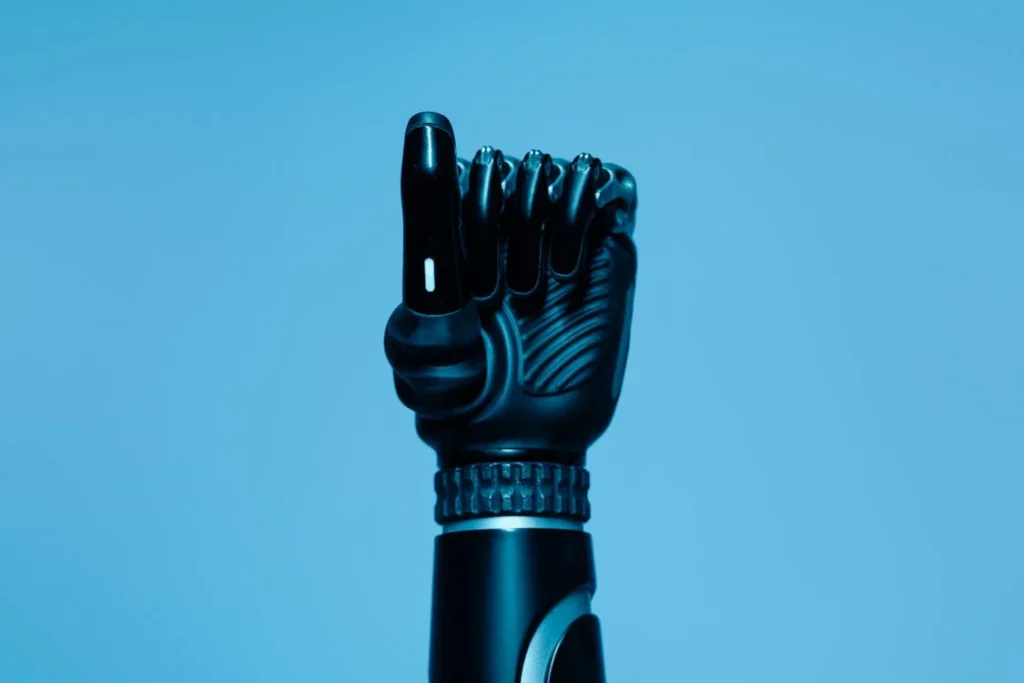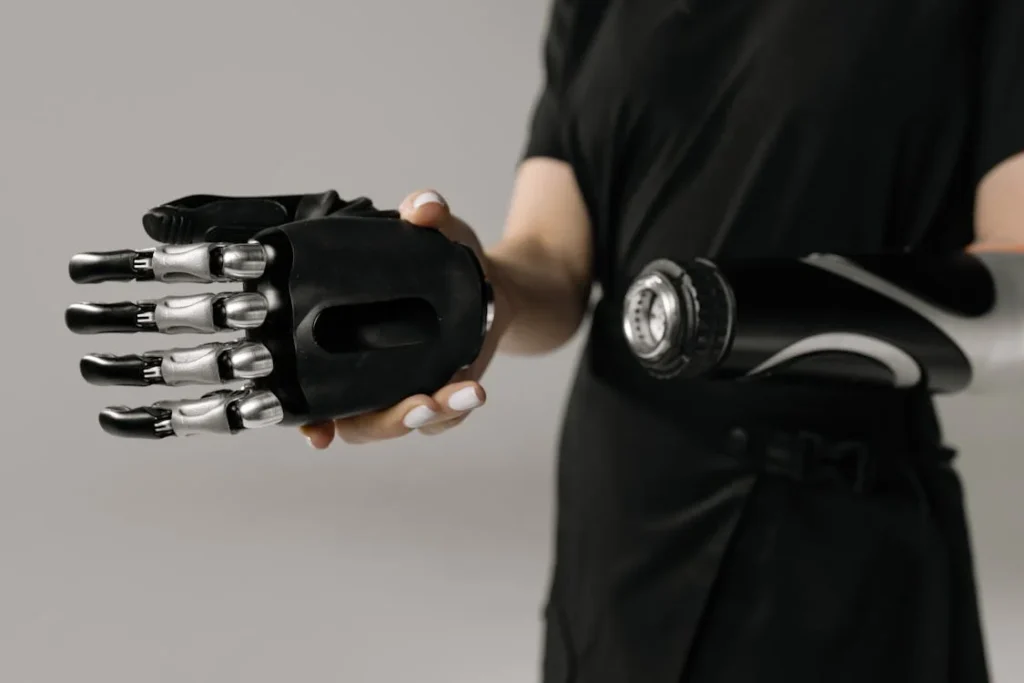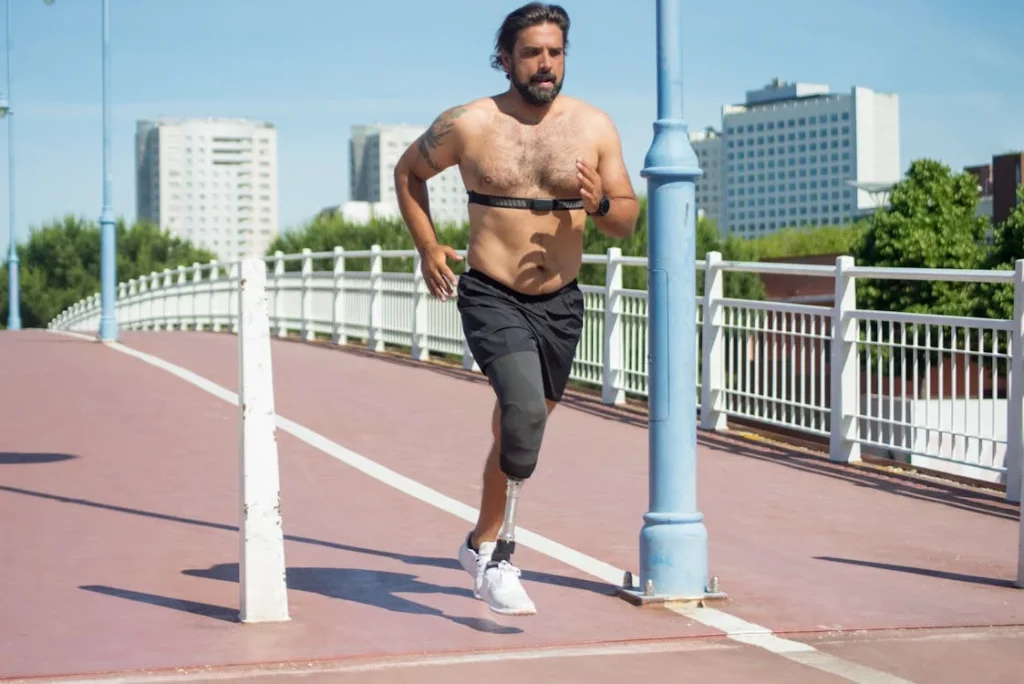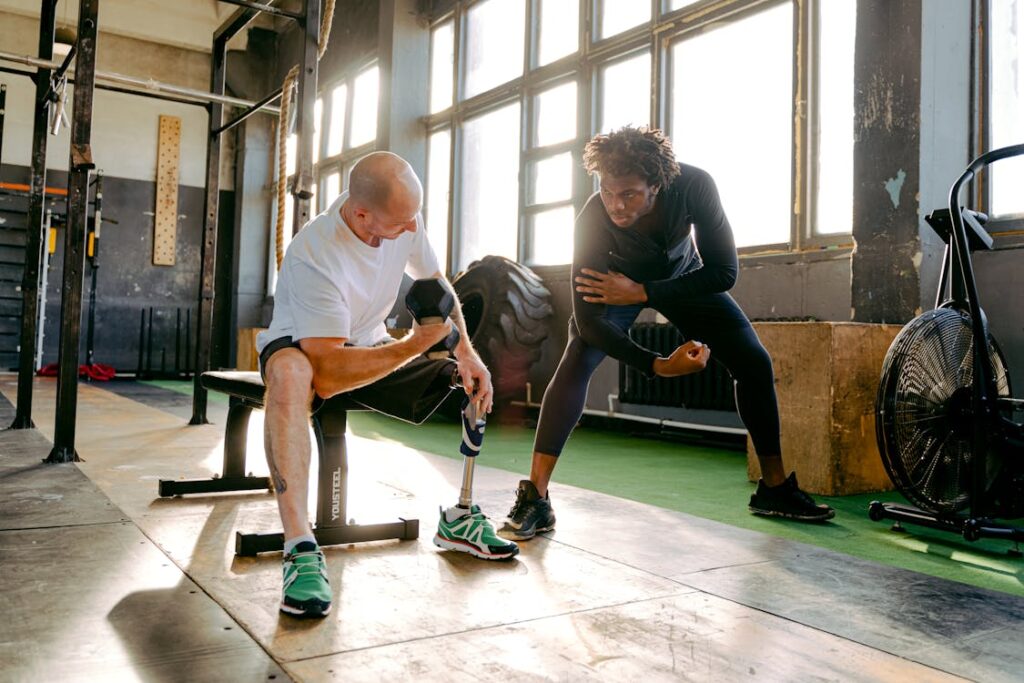Losing a limb is a life-changing experience, but modern bionic prosthetics have given people the ability to regain mobility and independence. While traditional prosthetic limbs restore movement, they lack one crucial element—the sense of touch. Without feeling, even the most advanced prosthetic hands or legs can seem disconnected from the user’s body, making simple tasks more challenging and less intuitive.
Thanks to breakthroughs in sensory technology, scientists and engineers are developing prosthetics that allow users to “feel” again. These innovations aim to create a more natural connection between the brain and an artificial limb, helping users sense textures, pressure, and even temperature. This new wave of prosthetic technology is not just about movement—it’s about restoring a lost sense and bringing artificial limbs closer to real human experience.

How Sensory Technology in Bionic Prosthetics Works
For decades, prosthetic limbs have focused on restoring movement, but without the ability to feel, users often struggle with everyday tasks. Sensory technology is now changing that by making artificial limbs more responsive and lifelike.
The key to this advancement lies in how prosthetic devices communicate with the brain. By creating a direct link between a bionic limb and the nervous system, scientists have made it possible for users to experience sensation in ways that were once thought impossible.
The Role of Sensory Feedback in Bionics
The human body relies on sensory feedback to perform even the simplest movements. When you hold a cup, your fingers automatically adjust grip strength based on how heavy or fragile the object feels.
Without this feedback, you would have to rely entirely on vision to judge how much pressure to apply. This is the challenge that prosthetic users have faced for years.
A bionic hand may be able to grip, but without sensory feedback, the user must visually monitor every movement, which can make even basic tasks exhausting.
To solve this problem, scientists have developed sensory technology that allows bionic limbs to send signals back to the brain. These systems use sensors embedded in the prosthetic to detect pressure, texture, or temperature.
The collected data is then transmitted to the user’s nervous system, enabling them to feel sensations similar to those of a natural limb.
This breakthrough makes it possible for users to hold delicate objects, detect different surfaces, and even feel a sense of connection between their prosthetic and their body.
Nerve Interfaces and Direct Brain Communication
One of the biggest advancements in sensory prosthetics is the development of nerve interfaces, which allow artificial limbs to connect directly to the nervous system.
Traditional prosthetics operate using muscle signals, but sensory prosthetics go a step further by stimulating the nerves that once controlled the lost limb.
Scientists achieve this by implanting small electrodes in the residual limb, where they can interact with existing nerves.
When a prosthetic hand touches an object, the sensors in the fingers send signals through these electrodes, activating the nerves and creating the sensation of touch.
The brain interprets these signals just as it would with a real hand, allowing users to feel as though they are truly interacting with their environment.
Some advanced research projects have even explored direct brain-machine interfaces, where electrodes are placed on the brain itself. This method bypasses the residual limb entirely and allows a prosthetic to be controlled purely by thought.
Early trials have shown promising results, with users able to sense and manipulate objects with an unprecedented level of precision.
Haptic Feedback and Artificial Touch
Another approach to sensory prosthetics is haptic feedback, a technology that mimics the sense of touch by applying vibrations or electrical stimulation to the skin.
When a bionic limb comes into contact with an object, the sensors trigger small pulses on the user’s arm, simulating the feeling of pressure or texture.
This technique does not require invasive surgery and can be integrated into existing prosthetics, making it a practical option for a wider range of users.
While haptic feedback does not yet replicate touch as perfectly as natural skin, it is a major step toward making bionic limbs feel more real.

The Life-Changing Impact of Sensory Bionic Prosthetics
The introduction of sensory feedback in bionic prosthetics is doing more than just restoring function; it is transforming the lives of those who use them.
The ability to feel through an artificial limb changes how people interact with the world, improves confidence, and reduces the mental effort required for everyday tasks.
These advancements are not just about technology—they are about restoring a sense of wholeness to individuals who have experienced limb loss.
Regaining Precision and Control
For years, people using prosthetic limbs have had to rely on visual cues and trial-and-error to complete simple tasks. Without touch, even picking up an object required intense concentration.
Sensory prosthetics eliminate this challenge by allowing users to instinctively adjust their grip based on real-time feedback. If a prosthetic hand detects that an object is fragile, it can automatically reduce grip strength.
This makes actions like holding an egg, gripping a pen, or shaking hands feel more natural and effortless.
For lower-limb prosthetic users, sensory feedback improves balance and coordination. Walking without sensation in the feet requires constant focus to avoid tripping or misstepping.
With sensory technology, bionic legs can send signals to the brain that help users detect the firmness of the ground, whether they are walking on grass, gravel, or a hard surface. This allows for more natural movement, reducing the risk of falls and improving overall stability.
Emotional and Psychological Benefits
One of the less talked-about effects of limb loss is the emotional impact. Many people struggle with the feeling that their prosthetic is a separate tool rather than part of their body.
This disconnect can make it difficult to fully adapt, leading to frustration, self-consciousness, and even anxiety in social situations. Sensory prosthetics change this experience by creating a direct connection between the artificial limb and the brain.
When a person can feel with their prosthetic, it no longer feels like an external object—it becomes an extension of their body. This creates a deeper sense of ownership and control, making it easier for users to accept and integrate their prosthetic into daily life.
Studies have shown that people using sensory prosthetics report a greater sense of confidence, improved emotional well-being, and a stronger connection to their artificial limb.
The Role of Sensory Prosthetics in Reducing Phantom Limb Pain
Many amputees experience phantom limb pain, a condition where they feel pain or discomfort in the missing limb. This occurs because the brain still expects sensory input from the lost limb and can misinterpret the absence of signals as pain.
Sensory prosthetics may help reduce phantom limb pain by reintroducing sensation to the affected nerves.
By stimulating the nervous system with real sensory feedback, these prosthetics provide the brain with the missing signals it expects, reducing the confusion that leads to phantom limb pain.
Early research suggests that users who receive sensory input through their prosthetic experience less frequent and less intense phantom limb pain episodes. This breakthrough is offering new hope for those who have struggled with this condition for years.
A More Natural and Intuitive Experience
The combination of sensory feedback, nerve interfaces, and haptic stimulation is bringing prosthetic limbs closer than ever to the experience of a natural limb.
As this technology continues to advance, the goal is to create bionic prosthetics that require no conscious effort to use. The brain and body will work together seamlessly, allowing users to move, feel, and interact with their environment without thinking about their prosthetic.
This progress is already changing how people approach daily life, from completing simple tasks to engaging in physical activities with greater ease.
Whether it’s picking up a child, walking barefoot on different surfaces, or feeling the grip of a handshake, sensory prosthetics are making these moments feel real again.

Challenges and Limitations of Sensory Bionic Prosthetics
While sensory bionic prosthetics are a major breakthrough in medical technology, they still come with challenges that must be addressed before they become widely available.
From technical complexities to cost barriers, these obstacles impact accessibility and usability. Researchers and engineers continue to refine the technology to make it more practical for everyday use, but several key challenges remain.
High Cost and Limited Availability
One of the biggest barriers to widespread adoption of sensory prosthetics is the high cost. These advanced devices require specialized materials, complex electronic components, and sophisticated software, all of which contribute to their expense.
Unlike traditional prosthetics, which are already costly, sensory-enabled bionic limbs come with additional expenses related to surgical procedures, calibration, and maintenance.
Additionally, most health insurance providers do not yet fully cover sensory prosthetic technology, making it difficult for many individuals to afford these advanced devices.
This issue is especially significant in countries with limited access to cutting-edge medical technology.
Efforts are being made to reduce costs through 3D printing, open-source designs, and government-supported prosthetic programs, but there is still a long way to go before these devices become accessible to everyone who needs them.
Complex Surgical and Training Requirements
Many sensory prosthetics rely on nerve interfaces or implanted electrodes, which means they require surgery to fully integrate with the user’s nervous system.
While these procedures are becoming safer and more effective, they still come with risks, including potential nerve damage, infection, and long recovery periods.
Even for non-invasive sensory prosthetics that use haptic feedback or surface sensors, users often need extensive training to learn how to interpret and respond to the new sensory input.
Since artificial sensation does not feel exactly like natural touch, it can take time for the brain to adjust. Some users experience sensory overload or confusion in the early stages, requiring weeks or even months of rehabilitation to fully adapt.
Durability and Technical Limitations
Bionic prosthetics, especially those with sensory feedback, require regular maintenance and software updates to function properly.
The sensors used to detect pressure, texture, and temperature must be highly sensitive, but they also need to be durable enough to withstand daily wear and tear.
Current models still face challenges in environments with extreme temperatures, moisture, or heavy physical strain, which can cause malfunctions or degrade the sensors over time.
Battery life is another concern. Many sensory prosthetics rely on external power sources, meaning they must be charged regularly.
A dead battery can render the sensory functions useless until the device is powered up again, which can be inconvenient for users who rely on constant feedback for daily activities.
Researchers are exploring alternative power sources, such as body heat or kinetic energy harvesting, but these technologies are not yet widely available.
The Challenge of Replicating Natural Sensation
While current sensory prosthetics can restore some degree of touch, they do not yet fully replicate the complexity of natural human sensation.
The human nervous system is incredibly advanced, capable of detecting minute temperature changes, subtle variations in pressure, and fine details in texture. Even the most advanced artificial sensory systems struggle to match this level of precision.
Additionally, some users report that artificial sensory input feels “unnatural” at first. Unlike biological touch, which the brain instinctively understands, sensory feedback from a bionic prosthetic must be learned and interpreted.
This learning curve varies from person to person, and while most users adapt over time, the experience is still different from having a natural limb.
Despite these challenges, researchers are making steady progress in improving realism, comfort, and usability. The goal is to create prosthetics that not only restore function but also feel indistinguishable from a real limb.

The Future of Sensory Bionic Prosthetics
The advancements in sensory bionic prosthetics are only the beginning. Researchers and engineers are continuously working toward a future where artificial limbs are not just functional replacements but fully integrated extensions of the human body.
The focus is shifting from simply restoring movement to creating a seamless connection between the brain, nerves, and prosthetic device.
The future of bionic prosthetics lies in improving the quality of sensory feedback, enhancing comfort, and making these technologies more accessible to people around the world.
Advancements in Neural Integration
One of the most exciting developments in sensory prosthetics is the improvement of neural integration. Currently, nerve interfaces allow some degree of sensory feedback, but researchers are exploring more precise ways to connect prosthetics directly to the nervous system.
Future prosthetics may feature enhanced neural implants that provide a more accurate representation of touch, allowing users to feel objects with the same sensitivity as a natural limb.
Scientists are studying ways to map nerve signals in greater detail so that prosthetics can send more complex sensory information to the brain.
Instead of relying solely on muscle contractions or external sensors, future prosthetics may be able to recognize intentions before movement occurs, making actions more fluid and intuitive.
These improvements will allow users to experience near-instantaneous responses from their artificial limbs, reducing the effort required to control them and making them feel more like a part of the body.
Artificial Skin and Temperature Sensation
Another major area of research is artificial skin, which aims to recreate the texture and sensory capabilities of human skin. Scientists are developing flexible, stretchable materials embedded with ultra-thin sensors that can detect pressure, temperature, and texture.
Unlike current prosthetics, which rely on external sensors to relay touch information, artificial skin will allow for a more direct and natural way to experience the world.
The ability to sense temperature is an especially important advancement. Traditional prosthetics provide no warning when a user comes into contact with something extremely hot or cold, increasing the risk of burns or injuries.
Future bionic limbs may include temperature-sensitive materials that can send real-time alerts to the nervous system, helping users react just as they would with a natural limb.
Self-Healing and Adaptive Prosthetics
Prosthetics of the future will not only provide sensory feedback but also adapt to the user’s body over time.
Research into self-healing materials is making it possible for prosthetics to repair minor damage on their own, reducing maintenance needs and making artificial limbs more durable.
These materials mimic the properties of human skin and tissue, allowing prosthetics to remain in optimal condition even after years of use.
Adaptive prosthetics are another emerging innovation. Future prosthetics will have the ability to adjust their shape and responsiveness based on the user’s movements.
This means that a prosthetic hand could change its grip strength automatically depending on the object being held, or a prosthetic leg could alter its stiffness based on whether the user is walking, running, or climbing stairs.
These advancements will bring prosthetic limbs even closer to the capabilities of a biological limb.
AI-Powered Learning and Personalized Sensory Experience
Artificial intelligence is playing a growing role in the future of bionic prosthetics. Machine learning algorithms are being developed to analyze user habits and refine sensory responses over time.
The more a person uses their prosthetic, the better it will become at recognizing their needs and adjusting accordingly. This will make movements feel even more natural and help the prosthetic learn how to improve grip pressure, walking balance, and fine motor control.
Another area of research focuses on personalizing sensory experiences. Every person experiences touch in a unique way, and future prosthetics may be able to adjust sensitivity based on individual preferences.
Some users may prefer stronger sensory feedback, while others may find subtle sensations more comfortable. AI-driven prosthetics could allow users to fine-tune their sensory input, creating a fully customized experience.
Making Sensory Prosthetics More Affordable and Accessible
While technological advancements are exciting, they also need to be accessible to those who need them most. Currently, high-tech bionic prosthetics are expensive, but researchers are looking for ways to lower production costs.
The use of 3D printing, lightweight materials, and scalable manufacturing techniques could make sensory prosthetics more affordable without compromising quality.
Companies and research institutions are also working on open-source prosthetic designs, allowing more people to benefit from advanced technology at a lower cost.
Governments and healthcare organizations are starting to recognize the importance of prosthetic accessibility, and future policies may provide better funding and insurance coverage for high-tech prosthetics.
As these efforts continue, more individuals will have access to sensory prosthetics that can restore not just movement but also the ability to feel.
The future of sensory bionic prosthetics is full of possibilities. As science continues to bridge the gap between artificial limbs and natural human sensation, the next generation of prosthetics will offer unprecedented levels of control, comfort, and adaptability.
These advancements are not just improving mobility; they are redefining what it means to feel, move, and interact with the world after limb loss.

The Role of Sensory Bionic Prosthetics in Everyday Life
The ability to feel through a prosthetic limb is more than just a scientific achievement—it has a profound impact on how people engage with the world. Sensory bionic prosthetics are changing everyday experiences, making routine tasks easier and more natural.
From personal interactions to professional work and recreational activities, the integration of touch into prosthetic limbs is reshaping what is possible for individuals with limb loss.
Improving Daily Tasks and Independence
For years, people using traditional prosthetics had to rely on sight and guesswork to complete basic tasks.
Simple activities like picking up a fragile glass, tying shoelaces, or holding a piece of paper required intense focus because there was no way to feel pressure or adjust grip strength naturally.
Sensory prosthetics eliminate this challenge by restoring touch, allowing users to instinctively adapt to different objects and surfaces.
Cooking, for example, becomes much easier when a prosthetic hand can detect how firmly it is holding a knife or sense the weight of an ingredient.
People can write more comfortably, handle money with ease, and navigate public spaces without worrying about misjudging force or grip. This makes everyday independence more seamless, allowing users to move through life with fewer restrictions.
For those with lower-limb prosthetics, sensory feedback helps improve walking posture and confidence. Navigating stairs, stepping onto a curb, or walking on uneven ground becomes safer when the prosthetic can detect the surface beneath it.
Users no longer have to rely entirely on their vision or compensate with unnatural movements, reducing physical strain and making walking more effortless.
Enhancing Social and Emotional Connections
Physical touch is a fundamental part of human interaction, and sensory prosthetics are helping restore that experience. A handshake, a pat on the back, or holding a loved one’s hand can carry deep emotional significance.
Traditional prosthetics, while functional, often feel cold and mechanical, creating a sense of distance in personal interactions. Sensory-enabled prosthetics bridge this gap by allowing users to feel these small yet meaningful moments again.
For parents with limb loss, the ability to feel their child’s hand in their own or sense the pressure of a hug is life-changing. These prosthetics make interactions feel more natural, helping users connect more fully with their surroundings and the people in their lives.
Studies have shown that individuals who use sensory prosthetics report a greater sense of belonging and emotional well-being, as their artificial limb feels less like a tool and more like a real part of them.
Expanding Career and Work Opportunities
Many professions require precise hand control, and for years, individuals with upper-limb prosthetics faced limitations in certain fields.
Jobs that involve fine motor skills, such as surgeons, electricians, or mechanics, were challenging because prosthetics lacked the ability to feel and adjust accordingly. With sensory bionic prosthetics, users can now perform delicate work with greater confidence and accuracy.
Artists and musicians, for example, can use advanced prosthetic hands to paint, sculpt, or even play instruments with a level of dexterity that was once impossible.
Sensory feedback allows them to judge how much pressure to apply to a brushstroke or how firmly to press a piano key. This opens up new career possibilities and creative opportunities for individuals who may have once felt limited in their professional choices.
In industrial and manual labor settings, workers with bionic prosthetics can now perform tasks with greater ease. The ability to sense weight, pressure, and texture helps in gripping tools, lifting objects safely, and working with precision.
This not only expands employment opportunities but also allows individuals to remain competitive in their chosen careers without being held back by prosthetic limitations.
Making Recreational Activities More Accessible
Beyond work and daily tasks, sensory prosthetics are also making recreational activities more enjoyable. Sports, outdoor adventures, and hobbies that require touch and balance are becoming more accessible.
Rock climbers with sensory prosthetics can now feel the texture of a climbing surface and adjust their grip in real time. Cyclists can better control their handlebars with prosthetic hands that provide pressure feedback, reducing the risk of slipping.
For lower-limb prosthetic users, sensory technology helps with activities such as hiking, dancing, and even swimming.
The ability to feel how the prosthetic interacts with different surfaces gives users better control over their movements, making physical activities safer and more natural.
As these technologies continue to improve, sensory prosthetics will allow users to engage in more aspects of life without hesitation.
Whether it’s pursuing a passion, strengthening personal relationships, or excelling in a career, the integration of touch into prosthetic limbs is giving people more freedom to live on their own terms.

The Science Behind Artificial Touch: How the Brain Adapts to Sensory Prosthetics
Sensory bionic prosthetics are not just about technology—they are also about how the human brain adapts to and interprets artificial touch.
The way the brain processes sensory information is incredibly complex, and researchers are finding that when given the right signals, it can accept input from an artificial limb just as it would from a natural one.
This ability, known as neuroplasticity, is what allows sensory prosthetics to feel real to the user over time.
How the Brain Interprets Artificial Sensations
The human sense of touch is controlled by a network of nerves that send signals to the brain when pressure, texture, or temperature is detected.
When a limb is lost, the nerves that once controlled it remain active, still expecting to receive sensory input. Sensory prosthetics take advantage of this by stimulating these nerves in a way that mimics natural touch.
For example, when a user grips an object with a sensory-enabled prosthetic hand, tiny sensors detect pressure and send electrical signals to implanted electrodes or external stimulation devices.
These signals are transmitted to the brain, where they are interpreted just like natural touch. Over time, users learn to recognize these signals as familiar sensations, allowing them to feel different levels of pressure, the shape of objects, and even subtle changes in texture.
Some prosthetic users report that their artificial touch sensations are not identical to what they remember from their biological limb. Instead, they describe them as tingling, vibrations, or pulses that their brain gradually learns to associate with real-world sensations.
This learning process varies from person to person, but many users find that after consistent use, their prosthetic begins to feel more like a natural part of their body.
Rewiring the Brain: The Role of Neuroplasticity
One of the most fascinating aspects of sensory prosthetics is the brain’s ability to rewire itself to accommodate new sensory input. This process, known as neuroplasticity, allows the brain to reorganize and form new neural connections in response to experiences.
When someone starts using a sensory prosthetic, their brain must adjust to interpreting artificial signals, which can take time and training.
Studies have shown that after weeks or months of using a sensory prosthetic, the brain remaps itself, integrating the prosthetic’s feedback into the body’s overall sensory system.
This is similar to how people who learn to read Braille develop heightened sensitivity in their fingertips. With repeated use, the brain begins treating the prosthetic’s sensations as normal touch, making the experience feel increasingly natural.
The Phantom Limb Connection
Neuroplasticity also plays a role in reducing phantom limb sensations, the phenomenon where amputees feel sensations, pain, or movement in their missing limb.
Phantom limb sensations occur because the brain still expects signals from the lost limb, and in the absence of real input, it sometimes generates its own.
Sensory prosthetics provide real sensory feedback, which can help the brain re-establish a connection with the artificial limb. Many users find that when their prosthetic sends touch signals back to the brain, phantom limb pain decreases or disappears altogether.
This suggests that giving the brain real input from a prosthetic limb can help restore a sense of normalcy and reduce the discomfort caused by missing sensory signals.
The Potential for Full Sensory Restoration
Researchers are now exploring ways to make sensory prosthetics feel even more natural. Some experiments involve stimulating multiple types of nerve fibers, allowing users to experience sensations beyond just pressure.
Future prosthetics may enable users to distinguish between smooth and rough textures, sense different temperatures, and even feel pain when necessary for safety, such as detecting a sharp object or extreme heat.
Brain-machine interfaces are also being tested as a way to create direct communication between prosthetics and the brain, bypassing the need for external electrodes.
If successful, these systems could allow prosthetic users to experience touch at an even higher level of precision, making artificial limbs virtually indistinguishable from natural ones.
As research continues, the dream of fully restoring the sense of touch to people with limb loss is becoming more of a reality. The combination of advanced technology and the brain’s ability to adapt is bringing prosthetic limbs closer than ever to true human sensation.
Conclusion
Sensory bionic prosthetics are transforming the way people with limb loss experience the world. By restoring the ability to feel, these advanced prosthetics go beyond mobility—they reconnect users with their surroundings, enhance daily activities, and improve emotional well-being. From detecting pressure and texture to reducing phantom limb pain, sensory feedback allows prosthetic limbs to function more naturally, making them feel like true extensions of the body.
Despite challenges such as cost, durability, and the need for further refinement, rapid advancements in neural interfaces, artificial skin, and brain-machine connections are pushing the boundaries of what prosthetics can achieve. As research continues, future prosthetics may offer even more precise touch, adaptive learning, and seamless brain integration.
At Robobionics, we are committed to bringing these innovations closer to reality, ensuring that prosthetic users regain not just movement, but also the rich sensory experience that makes human touch so essential. If you’re exploring advanced prosthetic solutions, reach out to us today and take the next step toward a future where feeling with a bionic limb is no longer a dream, but a reality.



